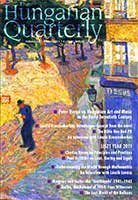Magyars and Serbs: the ’Southlands’ 1941–1945.The 1941 occupation of the Southlands and the 1942 round up
Magyars and Serbs: the ’Southlands’ 1941–1945.The 1941 occupation of the Southlands and the 1942 round up
Author(s): Enikő A. SajtiSubject(s): History
Published by: Society of the Hungarian Quarterly
Summary/Abstract: On 10 April 1941, four days after Germany attacked Yugoslavia and the day Croatia seceded from the state, Lt.-Col. Nenad Krnjajic commander of the 14th Garrison Regiment stationed in the Palic area in the Vojvodina region of Serbia, noted in his regimental journal: “Windy and cloudy; sleet. It is peaceful on our sector of the line. Minor Hungarian troop movements in the border area. On the radio the news is bad everywhere… The Germans broke through at Bela Crkva and are pushing forward… Lt.-Col. Ruzic, commander of 13th Garrison Regiment, informed me that Lt.-Col. Ivovnur [a Croat—E.S.], his second-in-command, has deserted.”1 The next day, on the orders of Miklós Horthy, the Regent of Hungary, units of the Hungarian Third Army and the Mobile Corps crossed the Hungarian– Yugoslav border. The main military objective, besides re-annexing the Backa (Bácska) region to Hungary, was to secure the rear of the German troops, advancing in the direction of Belgrade. That was done without any major engagement with the Yugoslav army, and within three days they had recaptured the Danube–Tisza interfluve, the Bács and the southern Baranja ‘Triangle’, thereby closing the era of Hungarian territorial gains. The last sentence of Lt.-Col. Krnjajic’s journal entry for 13 April runs: “As the best solution, I have ordered the destruction of all war material and am dispersing the unit.”
Journal: The Hungarian Quarterly
- Issue Year: 2011
- Issue No: 204
- Page Range: 105-121
- Page Count: 17
- Language: English

